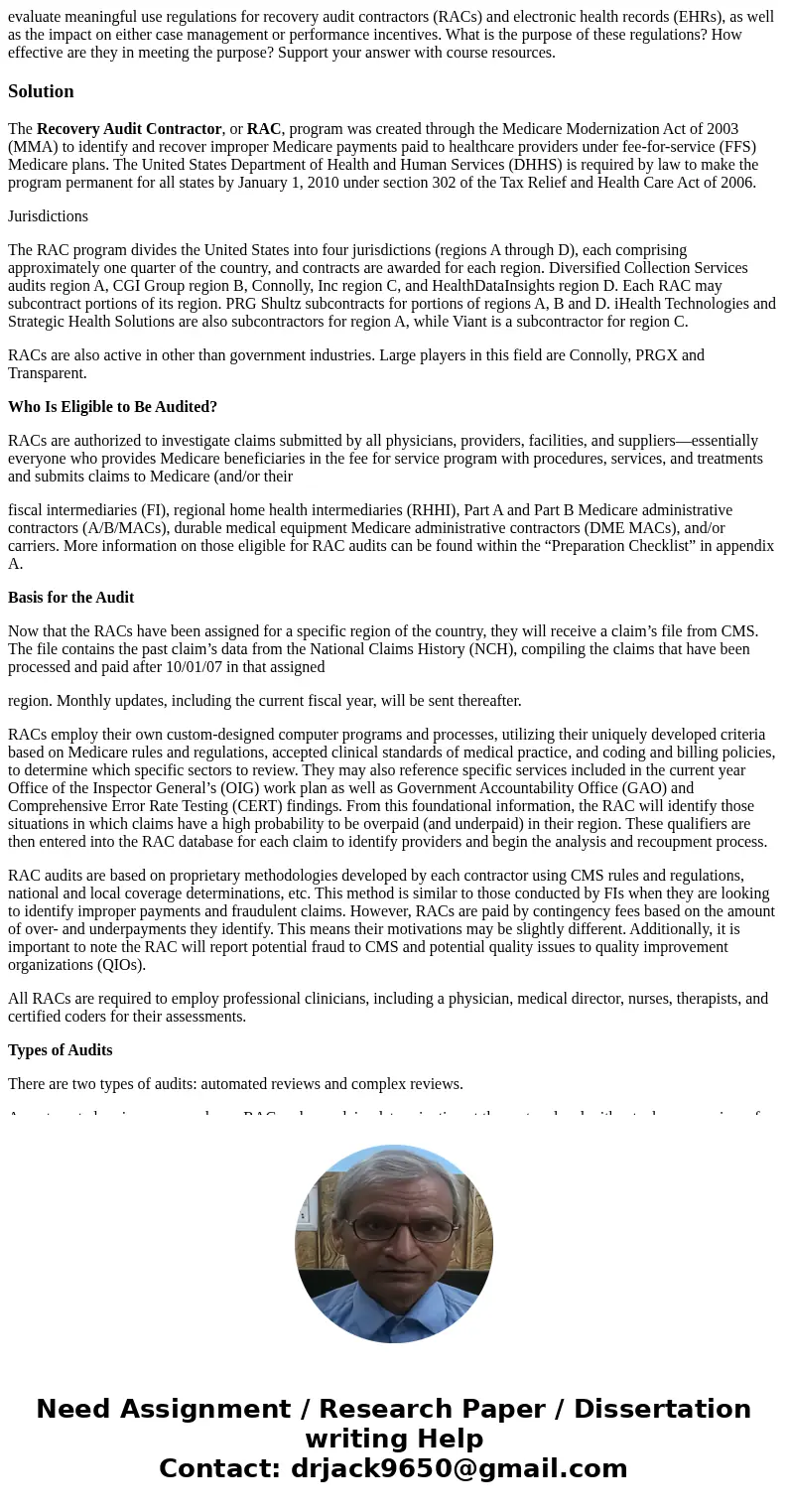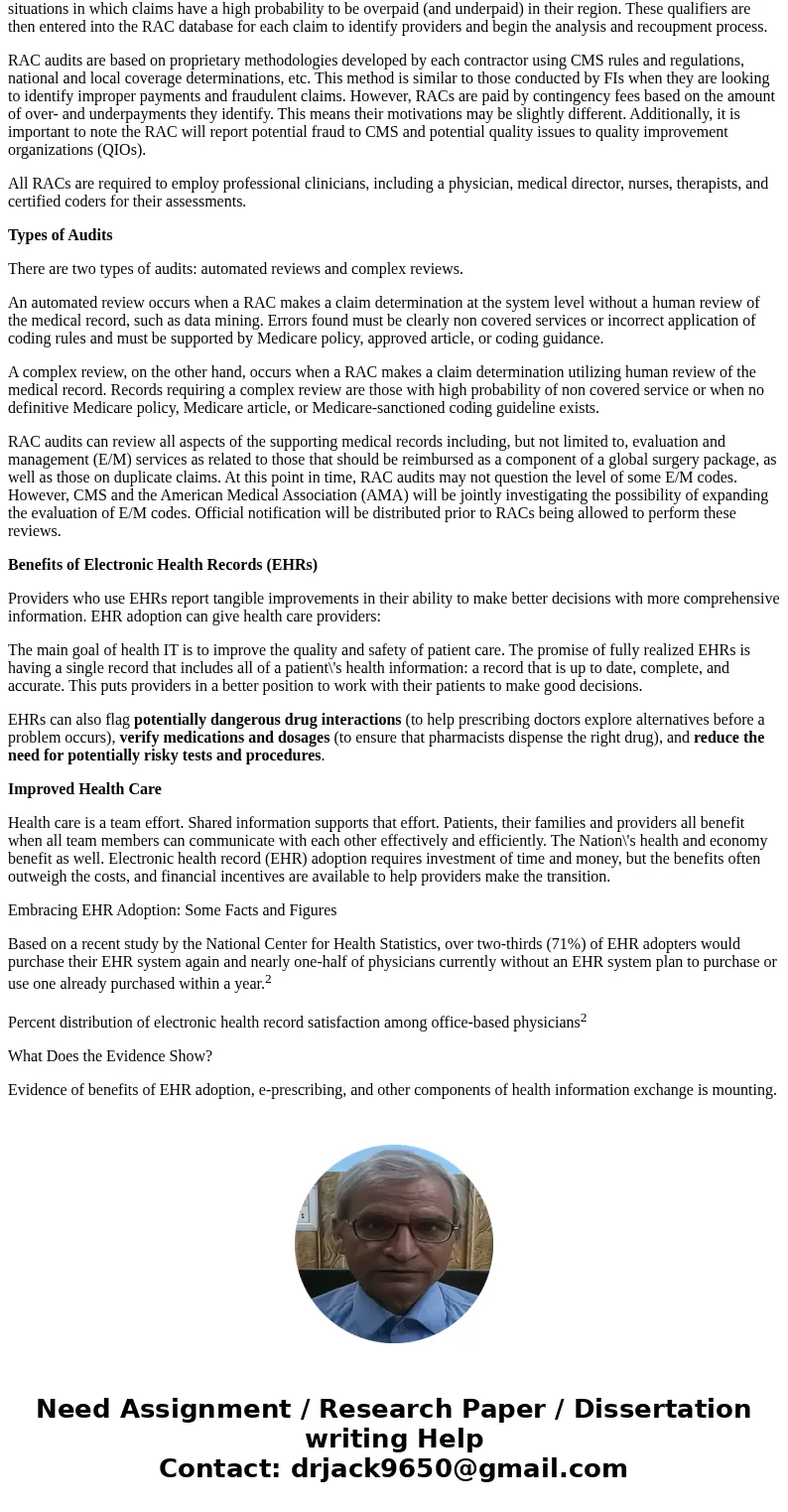evaluate meaningful use regulations for recovery audit contr
evaluate meaningful use regulations for recovery audit contractors (RACs) and electronic health records (EHRs), as well as the impact on either case management or performance incentives. What is the purpose of these regulations? How effective are they in meeting the purpose? Support your answer with course resources.
Solution
The Recovery Audit Contractor, or RAC, program was created through the Medicare Modernization Act of 2003 (MMA) to identify and recover improper Medicare payments paid to healthcare providers under fee-for-service (FFS) Medicare plans. The United States Department of Health and Human Services (DHHS) is required by law to make the program permanent for all states by January 1, 2010 under section 302 of the Tax Relief and Health Care Act of 2006.
Jurisdictions
The RAC program divides the United States into four jurisdictions (regions A through D), each comprising approximately one quarter of the country, and contracts are awarded for each region. Diversified Collection Services audits region A, CGI Group region B, Connolly, Inc region C, and HealthDataInsights region D. Each RAC may subcontract portions of its region. PRG Shultz subcontracts for portions of regions A, B and D. iHealth Technologies and Strategic Health Solutions are also subcontractors for region A, while Viant is a subcontractor for region C.
RACs are also active in other than government industries. Large players in this field are Connolly, PRGX and Transparent.
Who Is Eligible to Be Audited?
RACs are authorized to investigate claims submitted by all physicians, providers, facilities, and suppliers—essentially everyone who provides Medicare beneficiaries in the fee for service program with procedures, services, and treatments and submits claims to Medicare (and/or their
fiscal intermediaries (FI), regional home health intermediaries (RHHI), Part A and Part B Medicare administrative contractors (A/B/MACs), durable medical equipment Medicare administrative contractors (DME MACs), and/or carriers. More information on those eligible for RAC audits can be found within the “Preparation Checklist” in appendix A.
Basis for the Audit
Now that the RACs have been assigned for a specific region of the country, they will receive a claim’s file from CMS. The file contains the past claim’s data from the National Claims History (NCH), compiling the claims that have been processed and paid after 10/01/07 in that assigned
region. Monthly updates, including the current fiscal year, will be sent thereafter.
RACs employ their own custom-designed computer programs and processes, utilizing their uniquely developed criteria based on Medicare rules and regulations, accepted clinical standards of medical practice, and coding and billing policies, to determine which specific sectors to review. They may also reference specific services included in the current year Office of the Inspector General’s (OIG) work plan as well as Government Accountability Office (GAO) and Comprehensive Error Rate Testing (CERT) findings. From this foundational information, the RAC will identify those situations in which claims have a high probability to be overpaid (and underpaid) in their region. These qualifiers are then entered into the RAC database for each claim to identify providers and begin the analysis and recoupment process.
RAC audits are based on proprietary methodologies developed by each contractor using CMS rules and regulations, national and local coverage determinations, etc. This method is similar to those conducted by FIs when they are looking to identify improper payments and fraudulent claims. However, RACs are paid by contingency fees based on the amount of over- and underpayments they identify. This means their motivations may be slightly different. Additionally, it is important to note the RAC will report potential fraud to CMS and potential quality issues to quality improvement organizations (QIOs).
All RACs are required to employ professional clinicians, including a physician, medical director, nurses, therapists, and certified coders for their assessments.
Types of Audits
There are two types of audits: automated reviews and complex reviews.
An automated review occurs when a RAC makes a claim determination at the system level without a human review of the medical record, such as data mining. Errors found must be clearly non covered services or incorrect application of coding rules and must be supported by Medicare policy, approved article, or coding guidance.
A complex review, on the other hand, occurs when a RAC makes a claim determination utilizing human review of the medical record. Records requiring a complex review are those with high probability of non covered service or when no definitive Medicare policy, Medicare article, or Medicare-sanctioned coding guideline exists.
RAC audits can review all aspects of the supporting medical records including, but not limited to, evaluation and management (E/M) services as related to those that should be reimbursed as a component of a global surgery package, as well as those on duplicate claims. At this point in time, RAC audits may not question the level of some E/M codes. However, CMS and the American Medical Association (AMA) will be jointly investigating the possibility of expanding the evaluation of E/M codes. Official notification will be distributed prior to RACs being allowed to perform these reviews.
Benefits of Electronic Health Records (EHRs)
Providers who use EHRs report tangible improvements in their ability to make better decisions with more comprehensive information. EHR adoption can give health care providers:
The main goal of health IT is to improve the quality and safety of patient care. The promise of fully realized EHRs is having a single record that includes all of a patient\'s health information: a record that is up to date, complete, and accurate. This puts providers in a better position to work with their patients to make good decisions.
EHRs can also flag potentially dangerous drug interactions (to help prescribing doctors explore alternatives before a problem occurs), verify medications and dosages (to ensure that pharmacists dispense the right drug), and reduce the need for potentially risky tests and procedures.
Improved Health Care
Health care is a team effort. Shared information supports that effort. Patients, their families and providers all benefit when all team members can communicate with each other effectively and efficiently. The Nation\'s health and economy benefit as well. Electronic health record (EHR) adoption requires investment of time and money, but the benefits often outweigh the costs, and financial incentives are available to help providers make the transition.
Embracing EHR Adoption: Some Facts and Figures
Based on a recent study by the National Center for Health Statistics, over two-thirds (71%) of EHR adopters would purchase their EHR system again and nearly one-half of physicians currently without an EHR system plan to purchase or use one already purchased within a year.2
Percent distribution of electronic health record satisfaction among office-based physicians2
What Does the Evidence Show?
Evidence of benefits of EHR adoption, e-prescribing, and other components of health information exchange is mounting.


 Homework Sourse
Homework Sourse